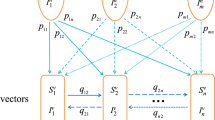Abstract
We derive a reaction–diffusion system modeling the spatial propagation of a disease with kinetics occurring on distinct spatial domains. This corresponds to the actual invasion of a disease from a species living in a given spatial domain toward a second species living in a different spatial domain. We study the global existence of solutions and discuss the long time behavior of solutions. Then we consider a special case, based on a model of brain worm infection from white-tailed deer to moose populations, for which we discuss the invasion success/failure process and disprove a conjecture stated in an earlier work.
Similar content being viewed by others
References
NTJ Bailey (1975) The Mathematical Theory of Infectious Diseases and its Applications EditionNumber2 Hafner Press New York 413
S Busenberg KC Cooke (1993) Vertically transmitted diseases, Biomathematics Volume 23 Springer Verlag New York 248
RS Cantrell C Cosner (2003) Spatial Ecology Via Reaction Equations John Wiley and Sons Chichester, UK 456
O Diekmann MCM De Jong AA De Koeijer P Reijnders (1995) ArticleTitleThe force of infection in populations of varying size: a modeling problem Journal of Biological Systems 3 519–529 Occurrence Handle10.1142/S0218339095000484
WE Fitzgibbon M Langlais (1997) ArticleTitleDiffusive SEIR models with logistic population control Communications on Applied Nonlinear Analysis 4 1–16
WE Fitzgibbon JJ Morgan R Sanders (1992) ArticleTitleGlobal existence and boundedness for a class of inhomogeneous semilinear parabolic equations Nonlinear Analysis TMA 19 885–899 Occurrence Handle10.1016/0362-546X(92)90057-L
WE Fitzgibbon C Martin JJ Morgan (1994) ArticleTitleUniform bounds and asymptotic behavior for a diffusive epidemic model with criss-cross dynamics Journal of Mathematical Analysis and Applications 184 399–414 Occurrence Handle10.1006/jmaa.1994.1209
WE Fitzgibbon M Langlais ME Parrott GW Webb (1995) ArticleTitleA diffusive system with age dependence modeling FIV Nonlinear Analysis TMA 25 975–989 Occurrence Handle10.1016/0362-546X(95)00092-A
WE Fitzgibbon M Parrott GF Webb (1995) ArticleTitleDiffusive epidemic models with criss-cross dynamics Mathematical Biosciences 128 131–155 Occurrence Handle10.1016/0025-5564(94)00070-G Occurrence Handle7606132
WE Fitzgibbon M Langlais JJ Morgan (1999) ArticleTitleEventually uniform bounds for a quasipositive reaction diffusion system Japan Journal of Industrial and Applied Mathematics 16 225–241
WE Fitzgibbon M Langlais JJ Morgan (2001) ArticleTitleA mathematical model of the spread of feline leukemia virus (FeLV) through a highly heterogeneous domain SIAM Journal of Mathematical Analysis 33 570–588 Occurrence Handle10.1137/S0036141000371757
WE Fitzgibbon M Langlais JJ Morgan (2004) ArticleTitleA reaction-diffusion system modeling direct and indirect transmission of a disease DCDS B 4 893–910
WE Fitzgibbon M Langlais JJ Morgan (2004) ArticleTitleA reaction diffusion system on non-coincident domains modeling the circulation of a disease between two host Populations Differential and Integral Equations 17 781–802
J Hale (1988) Asymptotic Behavior of Dissipative Systems American Mathematical Society Providence, Rhode Island 198
D Henry (1981) Geometric Theory of Semilinear Parabolic Equations Springer-Verlag Berlin 348
S Hollis RH Martin M Pierre (1987) ArticleTitleGlobal existence and boundedness in reaction diffusion systems SIAM Journal of Mathematical Analysis 18 744–761
OA Ladyzenskaja V Solonnikov N Ural’ceva (1968) Linear and quasilinear equations of parabolic type Translations of AMS 23 Providence, Rhode Island 736
JJ Morgan (1989) ArticleTitleGlobal existence for semilinear parabolic systems SIAM Journal of Mathematical Analysis 20 1128–1144 Occurrence Handle10.1137/0520075
JJ Morgan (1990) ArticleTitleBoundedness and decay results for reaction diffusion systems SIAM Journal of Mathematical Analysis 21 1172–1184 Occurrence Handle10.1137/0521064
GE Olsson N White C Ahlm F Elgh A-C Verlemyr P Juto (2002) ArticleTitleDemographic factors associated with hantavirus infection in bank voles (Clethrionomys glareolus) Emerging Infectious Diseases 8 924–929 Occurrence Handle12194768
A Pazy (1983) Semigroups of Linear Operators and Applications to Partial Differential Equations Springer Verlag Berlin 279
F Sauvage C Penalba P Vuillaume F Boue D Coudrier D Pontier et al. (2002) ArticleTitlePuumala hantavirus infection in humans and in the reservoir host, Ardennes region, France Emerging Infectious Diseases 8 1509–1511 Occurrence Handle12498675
F Sauvage M Langlais NG Yoccoz D. Pontier (2003) ArticleTitleModelling hantavirus in cyclic bank voles the role of indirect transmission on virus persistence Journal of Animal Ecology 72 1–13 Occurrence Handle10.1046/j.1365-2656.2003.00675.x
C Schmaljohn B Hjelle (1997) ArticleTitleHantaviruses: a global disease problem Emerging Infectious Diseases 3 IssueID2 95–104 Occurrence Handle9204290
OJ Schmitz TD Nudds (1994) ArticleTitleParasite-mediated competition in deer and moose: how strong is the effect of meningeal worm on moose? Ecological Applications 4 91–103
G Sell Y You (2002) Dynamics of Evolutionary Systems Springer-Verlag New York 670
J Shaman JF Day M Stieglitz (2002) ArticleTitleDrought-induced amplification of Saint Louis encephalitis virus Florida. Emerging Infectious Diseases 8 575–580
J Smoller (1983) Shock Waves and Reaction Diffusion Equations Springer Verlag New York 632
Author information
Authors and Affiliations
Corresponding author
Rights and permissions
About this article
Cite this article
Fitzgibbon, WE., Langlais, M., Marpeau, F. et al. Modeling the Circulation of a Disease Between Two Host Populations on non Coincident Spatial Domains. Biol Invasions 7, 863–875 (2005). https://doi.org/10.1007/s10530-005-5210-1
Received:
Accepted:
Issue Date:
DOI: https://doi.org/10.1007/s10530-005-5210-1




